The Catholic Rite of Marriage is a sacred sacrament celebrating the union of a man and woman, reflecting God’s love and commitment. Rooted in theology, it symbolizes a lifelong covenant sealed through mutual consent, prayer, and the Eucharist, emphasizing faith, fidelity, and family within the Church’s tradition.
Overview of the Sacrament of Marriage in the Catholic Church
The sacrament of marriage in the Catholic Church is a covenant between a man and woman, symbolizing God’s enduring love. It is rooted in natural law and elevated by Christ to a sacramental level, reflecting the union between Christ and his Church. Marriage is viewed as a lifelong commitment, sealed through mutual consent and fidelity. The sacrament is celebrated within the Church’s liturgical tradition, emphasizing prayer, the Eucharist, and the community’s witness. It is a sacred institution and a vocation, fostering holiness, unity, and the nurturing of family life. The Church teaches that marriage is indissoluble, reflecting God’s faithfulness and love for humanity.
Importance of the Rite of Marriage in Catholic Tradition
The Rite of Marriage holds profound significance in Catholic tradition as a sacrament that mirrors God’s love and fidelity. It is seen as a divine institution, foundational to family life and society. The ceremony, with its exchange of vows and rings, symbolizes a lifelong commitment and mutual surrender, reflecting Christ’s bond with his Church. This rite not only unites two individuals but also strengthens their faith and provides a moral framework for their relationship. The sacrament is celebrated within the Eucharistic liturgy, emphasizing its connection to the Church’s life and mission. It is a source of grace, fostering holiness and unity, and is deeply intertwined with Catholic identity and tradition.
Requirements for a Catholic Marriage
Catholic marriage requires baptismal certificates, freedom to marry, and pre-marriage counseling. Dispensations may be needed for interfaith unions, ensuring adherence to Church teachings and regulations.
Eligibility Criteria for Couples
To be eligible for a Catholic marriage, couples must meet specific criteria. Both partners must be baptized Christians, with at least one being a baptized Catholic. If one partner is not Catholic, they must be a baptized Christian, and a dispensation from the bishop may be required. Couples must also be free to marry, meaning they are not bound by a previous marriage or other canonical impediments. The Church emphasizes the importance of freedom, faith, and mutual consent. Documentation, such as baptismal certificates, is typically required to verify eligibility. Additionally, couples must undergo pre-marriage counseling to ensure they are prepared for the sacrament. These criteria ensure the validity and sacramental nature of the union within the Catholic Church.
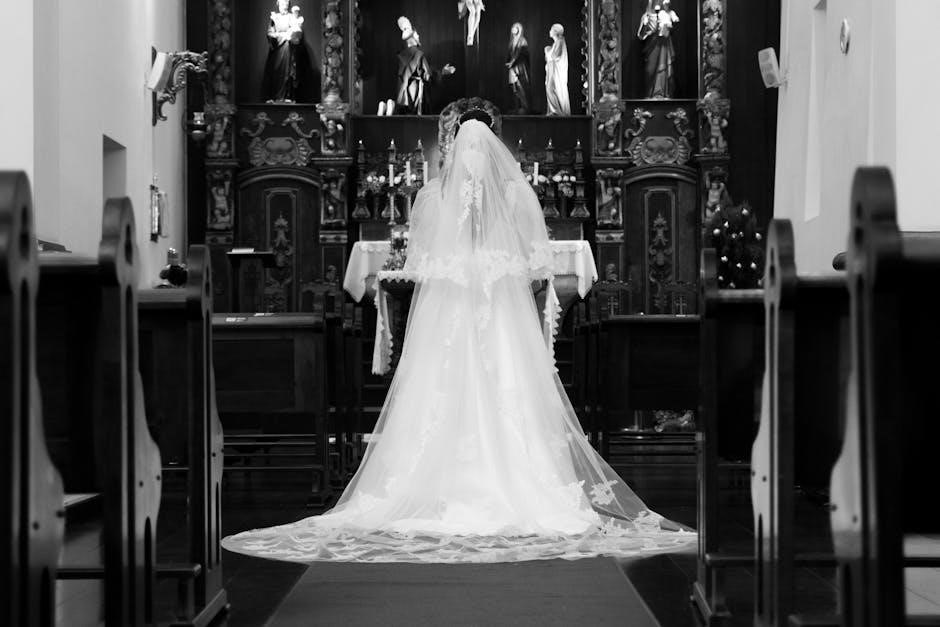
Role of Baptism in Catholic Marriage
Baptism plays a central role in Catholic marriage, as it is the foundation of the Christian life. For a marriage to be validly celebrated in the Catholic Church, at least one of the partners must be a baptized Catholic. Baptism initiates a person into the faith community and prepares them to receive the sacraments, including matrimony. During the marriage ceremony, the couple’s baptismal vows are renewed, symbolizing their commitment to faith and to each other. The lighting of candles often accompanies this renewal, representing the light of Christ guiding their union; Baptismal certificates are typically required to verify this sacramental foundation, ensuring the marriage is rooted in shared faith and spiritual unity.
Interfaith Marriages and Their Implications
Interfaith marriages in the Catholic Church involve one Catholic and one non-Catholic partner. The Church permits such unions but requires proper dispensation from the bishop. The non-Catholic partner must be baptized and share a commitment to Christian values. Couples must engage in pre-marriage discussions about faith, child-rearing, and mutual respect for religious traditions. The ceremony can take place within or outside the Mass, depending on the bishop’s approval. Open communication and unity in faith are essential for a harmonious marriage. The Church emphasizes the importance of shared spiritual foundations while respecting differences, ensuring the sacrament remains a covenant of love and fidelity.
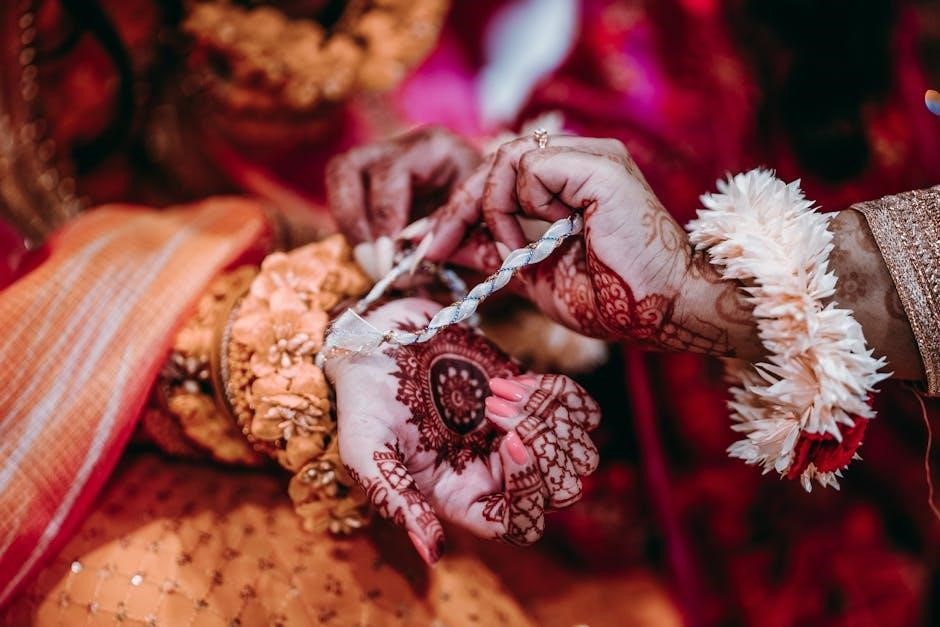
Preparation for the Catholic Rite of Marriage
Preparation involves pre-marriage counseling, meetings with the priest, and gathering necessary documents like baptismal certificates. Couples engage in discussions about faith, communication, and future goals, ensuring readiness for the sacrament.
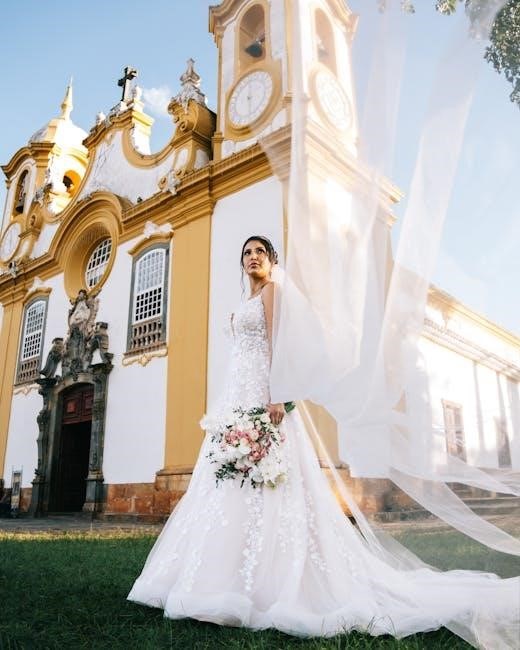
Pre-Marriage Counseling and Meetings
Pre-marriage counseling is a foundational step in preparing for the Catholic Rite of Marriage. Couples typically attend sessions led by a priest, deacon, or married couple. These meetings focus on communication, conflict resolution, and understanding the sacrament’s lifelong commitment. Discussions often cover faith, values, and future goals, fostering deeper unity and readiness. The priest assesses the couple’s understanding of the sacrament and ensures they are free and willing to enter into the covenant. These meetings also provide an opportunity for spiritual guidance and reflection, helping couples build a strong, faith-centered marriage. Regular attendance at these sessions is a requirement for celebrating the sacrament within the Church.
Documentary Requirements (Baptismal Certificates, etc.)
For a Catholic marriage, specific documents are required to ensure eligibility and compliance with Church regulations. Baptismal certificates for both individuals, issued within six months of the wedding date, are essential. These certificates must include notations of confirmation and any other sacraments received. If one partner is not Catholic, a baptismal certificate from their Christian denomination is required. Additional documents may include proof of freedom to marry, such as affidavits or witness statements. For previously married individuals, annulment decrees or death certificates of former spouses are necessary. In cases of interfaith marriages, a dispensation from the bishop may be required. These documents are typically submitted to the parish priest during pre-marriage preparations.
Engagement and Intent to Marry
The engagement period is a time for couples to deepen their commitment and prepare for the sacrament of marriage. The Catholic Church emphasizes the importance of publicly declaring their intent to marry, often through the announcement of the banns of marriage during Mass. This declaration ensures transparency and allows the community to witness their commitment. Couples are also expected to meet with their priest to discuss their intentions and ensure they are free to marry. The priest will guide them through the necessary preparations, including pre-marriage counseling and the completion of required documents. This period is a spiritual journey, helping the couple to discern God’s will and strengthen their relationship before the sacrament is celebrated. The Church encourages couples to approach this time with prayer and reflection, seeking to build a strong foundation for their future together. By declaring their intent to marry, the couple publicly affirms their love and commitment, paving the way for the sacred celebration of their union in the eyes of God and the Church. This step is crucial as it formalizes their decision and involves the community in their journey toward marriage. The Church’s requirements ensure that the couple is well-prepared to enter into this lifelong covenant with a clear understanding of its responsibilities and blessings.
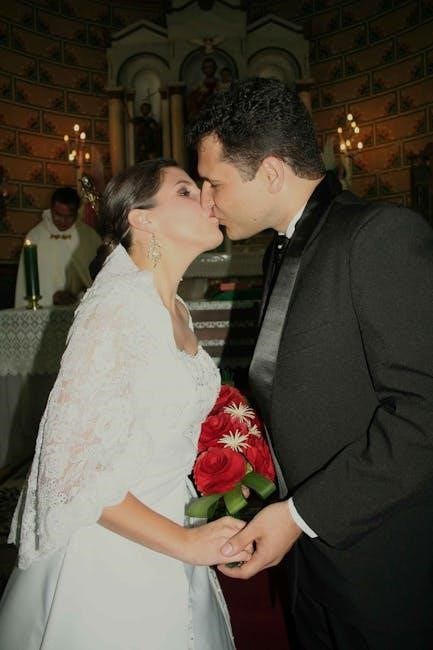
The Ceremony Itself
The ceremony begins with the Entrance Hymn, followed by the priest’s welcome and opening prayer. The couple exchanges vows and rings, symbolizing their lifelong commitment. If a Mass is celebrated, the Eucharist is central, culminating in the Prayer of the Faithful and Communion. The rite concludes with a final blessing and recessional, marking the newlyweds’ joyful departure.
Entrance Hymn and Welcome
The ceremony begins with an Entrance Hymn, setting a reverent tone as the bride, groom, and wedding party process into the church. The priest greets the assembly, welcoming everyone and invoking God’s blessings. This moment symbolizes the couple’s journey together, supported by their faith community. The hymn is chosen to reflect the sacredness of the occasion, often emphasizing themes of love, commitment, and divine grace. The welcome establishes the spiritual context, reminding all present that the union is not only a human bond but also a sacramental one. The priest’s words invite reflection on the seriousness and joy of the moment, as the couple prepares to exchange their vows.
Lighting of Candles and Opening Prayer
The Lighting of Candles and Opening Prayer mark the beginning of the sacred ritual, symbolizing the couple’s journey into a lifelong commitment. The candles, often lit by the bride and groom, represent the light of Christ guiding their union. The priest then offers an Opening Prayer, invoking God’s blessings and asking for guidance, strength, and unity for the couple. This prayer sets the tone for the ceremony, emphasizing the sacred nature of the vows they are about to exchange. The act of lighting candles also reflects the couple’s baptismal vows, reminding them of their faith journey and the divine presence in their marriage. This moment is a powerful reminder of the spiritual foundation of their union.
Address by the Priest
The priest begins by addressing the assembly, welcoming them and explaining the sacred nature of the marriage sacrament. He emphasizes the importance of marriage as a covenant rooted in faith, love, and mutual respect. The priest invites the couple to reflect on their commitment and recalls the virtues of fidelity, patience, and understanding. He also reminds the congregation of their role as witnesses and supporters of the couple’s union. This address serves as a spiritual foundation for the ceremony, encouraging the couple to build their relationship on prayer, trust, and unconditional love. The priest’s words are a call to embrace the challenges and joys of married life with grace and devotion; This moment is both a celebration and a solemn reminder of the sacred vows about to be exchanged.
Exchange of Vows
The exchange of vows is a pivotal moment in the Catholic Rite of Marriage, where the couple publicly declares their commitment to one another. Standing before the priest and the congregation, each partner promises to love and cherish the other, for better or for worse, in sickness and in health, until death. These vows are a sacred promise, rooted in mutual respect and fidelity, and are spoken freely and intentionally. The bride and groom address each other directly, affirming their willingness to enter into this lifelong covenant. Their vows reflect the Church’s understanding of marriage as a sacramental union, a bond strengthened by faith and sustained by God’s grace. The congregation witnesses this sacred exchange, offering prayerful support for the couple’s future together.
Exchange of Rings
The exchange of rings is a symbolic and sacred moment in the Catholic Rite of Marriage, representing the couple’s commitment to fidelity and unity. After the vows, the priest blesses the rings, which are then presented to the couple. The bride and groom each place a ring on the other’s finger, often accompanied by a promise to love and honor one another for a lifetime. The rings serve as a visible reminder of their covenant and the permanence of their union. Traditionally, the rings are inscribed with phrases like “I am my beloved’s and my beloved is mine,” emphasizing the eternal nature of their bond. This act underscores the sacramental character of marriage, sealing their commitment before God and the Church.
Nuptial Mass (If Applicable)
If the couple chooses to include a Nuptial Mass, it is a beautiful and sacred part of the Catholic Rite of Marriage. The Mass typically follows the exchange of vows and rings, emphasizing the Eucharist as a source of grace and strength for the newlyweds. The liturgy includes readings, prayers, and the Offertory, where the couple offers their union to God. The priest may also invite the couple to receive Holy Communion together, symbolizing their shared life in Christ. Special prayers are offered for the couple, asking for God’s blessings on their marriage. The Nuptial Mass deepens the sacramental character of the ceremony, uniting the couple’s commitment with the sacrifice of the Mass, and is often considered a profound way to consecrate their union.
Prayer of the Faithful
The Prayer of the Faithful, also known as the General Intercessions, is a meaningful part of the Catholic Rite of Marriage. It typically occurs after the Exchange of Vows and Rings, inviting the congregation to pray for the newlyweds and the broader community. The prayers are led by a deacon or a layperson, asking for God’s blessings on the couple, their families, and the Church. Specific intentions often include strength in their commitment, fidelity, and guidance in building a Christian home. This communal prayer emphasizes the role of the faith community in supporting the couple’s marriage and fostering a spirit of unity and shared faith.
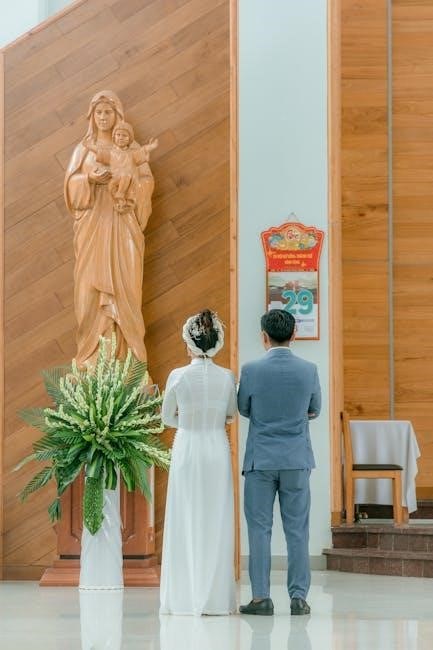
Communion Rite
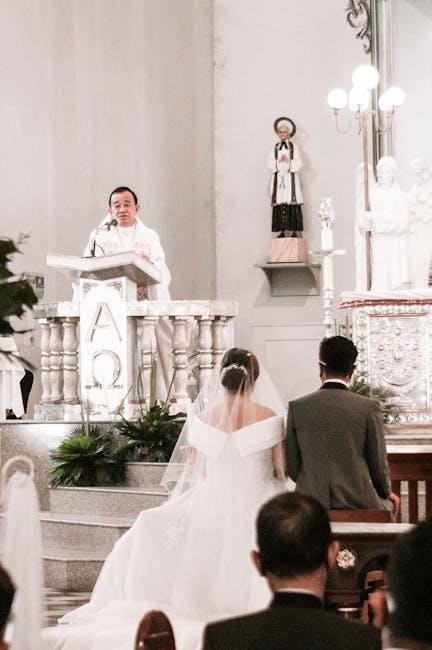
The Communion Rite is a profound moment in the Catholic Rite of Marriage, where the couple and the congregation receive the Eucharist. This sacrament symbolizes the couple’s unity with Christ and each other, strengthening their bond and commitment. The Eucharist is a source of grace, guiding them to live out their vows faithfully. The couple typically receives Communion together, signifying their shared journey in faith. This rite is deeply meaningful, as it nourishes their souls and reminds them of the sacramental nature of their marriage. It concludes the Nuptial Mass, preparing them to embark on their life together, rooted in love and fidelity.
Final Blessing and Recessional
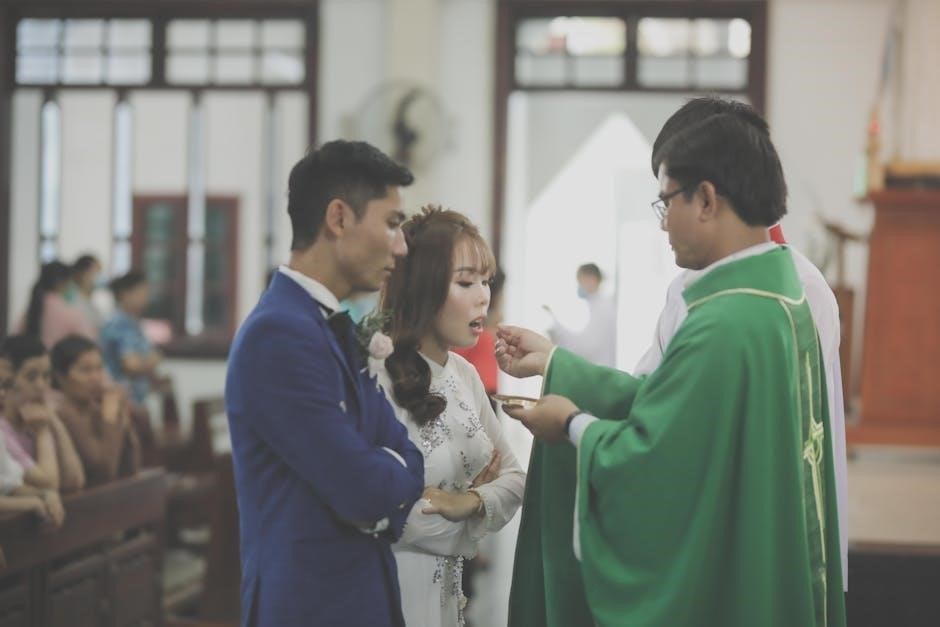
The Final Blessing and Recessional mark the joyful conclusion of the Catholic Rite of Marriage. The priest invokes God’s grace upon the newlyweds, asking for blessings on their union, fidelity, and future family. This moment is a powerful prayer, seeking divine protection and happiness for the couple. Following the blessing, the Recessional begins, where the wedding party exits the church, symbolizing the couple’s new life together. The congregation often applauds or sings a recessional hymn, celebrating the union. This final act embodies the community’s support and joy, sending the couple forth with hope and.
Marriage as a Sacrament
Marriage is a divine institution, a sacred covenant between a man and woman, symbolizing unity and selfless love, with Jesus as the model, reflecting God’s eternal bond with humanity.
Theological Understanding of Marriage
In Catholic theology, marriage is a sacrament instituted by God, symbolizing the union of Christ and the Church. It reflects divine love, fidelity, and self-giving, rooted in the nature of humanity as created by God. Marriage is a covenant between a man and woman, sealed by mutual consent, and oriented toward the good of the spouses and the procreation of children. The sacrament elevates the natural bond of marriage, infusing it with grace to strengthen the couple’s commitment. Through marriage, spouses participate in God’s plan of salvation, growing in holiness and reflecting Christ’s love in their relationship. The Eucharist, as a symbol of this union, deepens the theological understanding of marriage as a sacred vocation.
Marriage as a Covenant
Marriage in the Catholic Church is understood as a covenant, a sacred and unbreakable bond between a man and a woman, sealed by mutual consent and fidelity. This covenant reflects God’s covenantal love for humanity, emphasizing commitment, trust, and mutual support. The exchange of vows during the rite solemnizes this covenant, making it a lifelong partnership. The sacramental grace of marriage strengthens the couple to live out their commitment faithfully. As a covenant, marriage is not merely a contract but a sacred promise that unites the spouses in a shared life of love, service, and holiness. It mirrors the eternal covenant between God and humanity, rooted in divine love and fidelity.
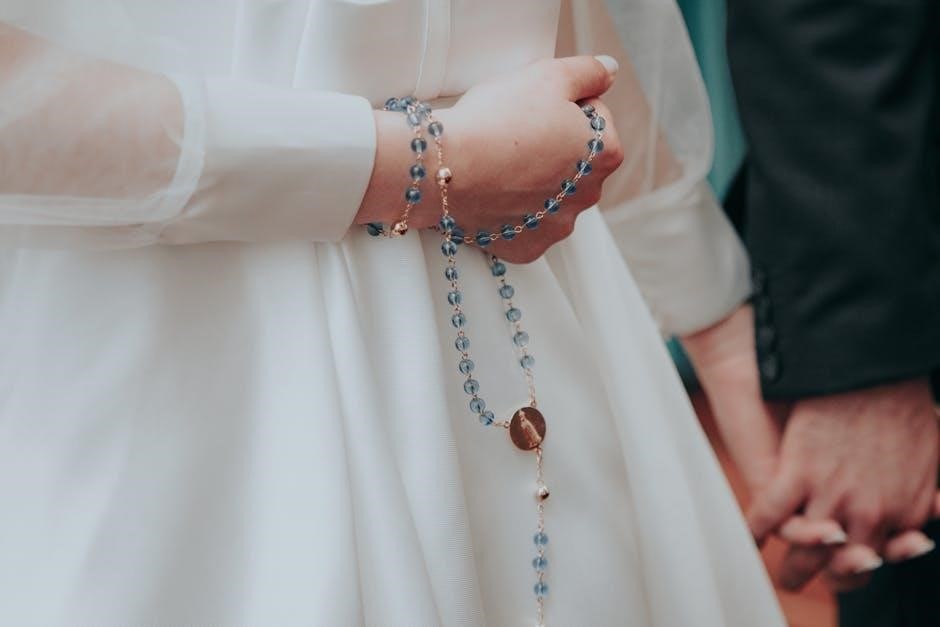
Practical Considerations
Practical considerations include understanding the order of the ceremony, preparing necessary documents, and engaging with resources to ensure a smooth and meaningful celebration of the sacrament.
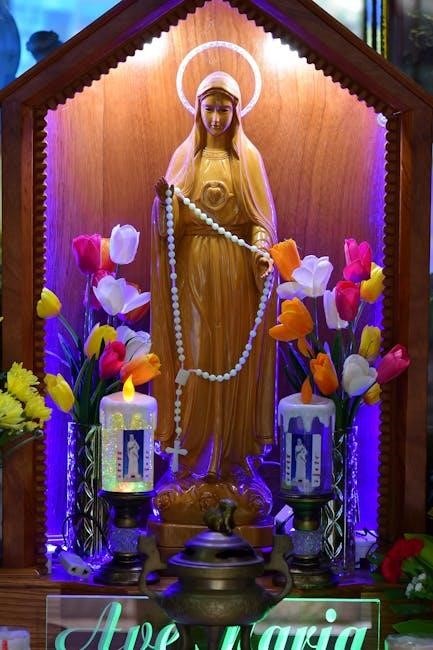
Order of Ceremony
The Catholic Rite of Marriage follows a structured order, ensuring a meaningful and sacred celebration. It begins with an Entrance Hymn and welcome by the priest. The Lighting of Candles symbolizes the couple’s commitment, followed by an Opening Prayer. The priest delivers an address, reflecting on marriage’s sacramental nature. The Exchange of Vows is a pivotal moment, where the couple publicly declares their commitment. This is followed by the Exchange of Rings, signifying their lifelong bond. If a Nuptial Mass is celebrated, the Prayer of the Faithful and Communion Rite are included. The ceremony concludes with a Final Blessing and Recessional, marking the newlyweds’ joyful exit.
Resources for Planning a Catholic Wedding
Planning a Catholic wedding requires access to essential resources to ensure a sacred and well-organized celebration. Couples can utilize official Catholic Church guidelines, available online or through their local parish. Many dioceses offer comprehensive wedding planning guides, detailing rituals, prayers, and requirements. Websites like St. Mary’s Catholic Center provide downloadable resources, such as mass booklets and reading selections. Additionally, pre-marriage counseling materials and checklists for documentary requirements are often available. Parish offices can assist with baptismal certificates and marriage license procedures. Online platforms also offer tools for creating ceremony programs and selecting appropriate hymns and readings, ensuring a meaningful and spiritually enriching experience.